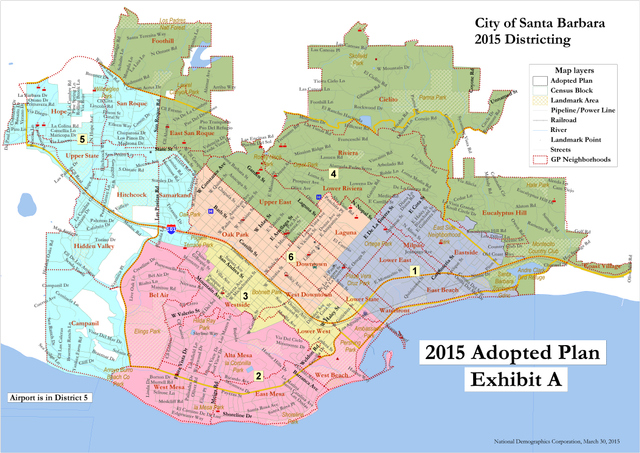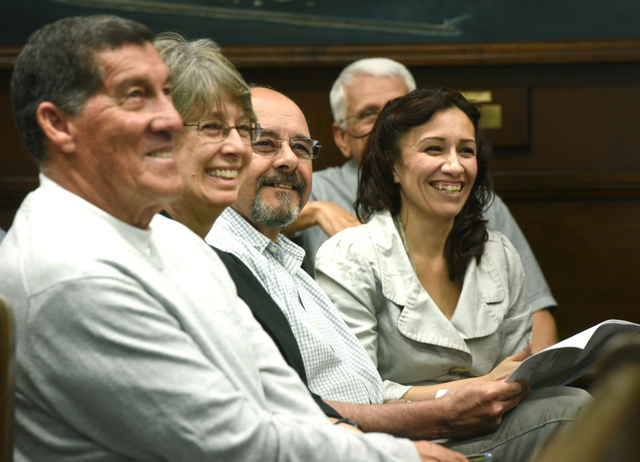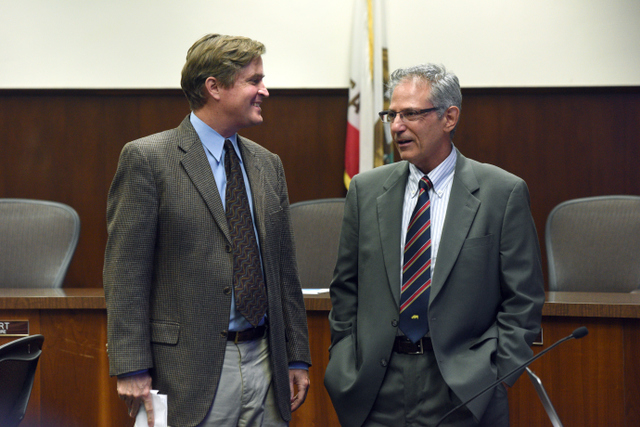District Election Map Finalized
Find Out What Precinct You're In

With a notable dearth of acrimony and a striking abundance of congratulatory goodwill, the Santa Barbara City Council put the finishing touches on the new voting districts by which city voters will now elect their councilmembers. The vote was six-to-one with Dale Francisco — resisting entreaties by fellow conservative Frank Hotchkiss to make it unanimous — casting the lone vote against.
This action all but brings to a close the lawsuit initiated last November alleging that Santa Barbara’s voting results — obtained via at-large elections — qualified as “racially polarized” under the California Voting Rights Act. In the past 45 years, only four Latinos have been elected to the City Council. City Hall was eager to settle; no government entity has yet to successfully defend itself against such allegations; the cost of protracted legal battle elsewhere has exceeded $3.2 million.
Find a high-resolution version of the map here.

The new map was drawn to guarantee that two of the six new districts would have what’s known in the legal lexicon as a “majority-minority population.” This does not guarantee the election of Latino candidates, but it greatly increases the odds. And based on the experience of other communities making the same switch, these districts should also see a significant increase in the number of qualified Latino candidates seeking elected office.
Politically progressive activists successfully lobbied the council into approving a voter map that would create a new downtown district dominated by renters, bus riders, and younger workers. Longtime political activist Dick Flacks proclaimed the moment “historic” and then — with tongue only somewhat in cheek — let loose with a celebratory “kumbaya!” To accommodate the creation of this high-renter district, San Roque — long considered Santa Barbara’s single most politically dominant neighborhood — had to be carved into two separate precincts. But even divided, San Roque’s die-hard voters will remain a potent force to be reckoned with.

Downtown Santa Barbara and State Street — the economic goose that lays the South Coast’s golden eggs — will wind up represented by not one but three councilmembers. And by an unintended consequence of the map-making process, the Entrada redevelopment project now rising up on the bottom of State Street by the Funk Zone will have two.
Some councilmembers expressed disappointment and resentment that so momentous a change was foisted upon residents by lawsuit rather than popular vote. Francisco castigated the new district election scheme for being “divisive” and expressed concern that voters would be asked to elect candidates based “on race, ethnic background, income, and even whether they ride the bus to work.” Francisco — recently elected chair of the county’s Republican Central Committee — opposed the split of San Roque, but neither he nor any conservative-minded organizations put much time into competitive map-making, with the exception of the Chamber of Commerce. The Chamber submitted two maps, but its main interest was in having multiple districts touch State Street, which the final map did.
All councilmembers expressed hope that future council-elects would act with the good of the city as a whole in mind, not just the districts they represented. Mayor Helene Schneider termed it, “Thinking ‘districty,’ but acting city-wide.” Activists with groups like CAUSE (Central Coast Alliance United for a Sustainable Economy) and SBCAN (S.B. County Action Network) urged the council to change elections from odd to even years as well, noting such a switch could increase voter turnout by as much as 20 percent in presidential years.
Notably silent were three of the five plaintiffs who brought the case against City Hall in the first place. Earlier that day, lead plaintiff Frank Bañales — who over the years has run for mayor and council, both unsuccessfully — expressed grim satisfaction with the outcome. District elections, Bañales said, would force City Hall to become more responsive to neighborhood-specific issues. “Now we won’t have to wait until another kid is killed on Milpas Street before they start setting up new street lights,” he said.
Judge Donna Geck is scheduled to review the final district maps on April 6. Three of the six districts will be fair game in this November’s election, but in two — the Westside and the Mesa — incumbents Cathy Murillo and Randy Rowse, respectively, will be seeking a second term, and no challengers have surfaced yet. Up for grabs will be the new Eastside district.
District Details
DISTRICT 1
Eastside, Lower East, Lower State, Waterfront, East Beach
Population: 14,865
69 percent Hispanic
Registered Voters: 5,735
Voted 2012: 4,395
62 percent renters
55 percent speak Spanish at home
44 percent make $50,000 or less
7 percent make $200,000 or more
DISTRICT 2
Mesa, West Beach, Bel Air
Population: 14,924
73 percent white
Registered Voters: 9,758
Voted in 2012: 8,027
56 percent homeowners
72 percent speak English at home
30 percent make $50,000 or less
11 percent make $200,000 or more
DISTRICT 3
Westside, Lower West
Population: 14,324
69 percent Hispanic
Registered Voters: 4,350
Voted in 2012: 3,209
72 percent renters
54 percent speak Spanish at home
45 percent make $50,000 or less
3 percent make $200
DISTRICT 4
Upper East, Riviera, Foothill, Cielito, Eucalyptus Hill, East San Roque
Population: 14,720
81 percent white
Registered Voters: 10,328
Voted in 2012: 8,840
57 percent homeowners
80 percent speak English at home
32 percent make $50,000 or less
15 percent make $200,000 or more
DISTRICT 5
Hidden Valley, Samarkand, Hitchcock, Upper State, Hope, West San Roque, Campanil
Population: 14,656
69 percent white
Registered Voters: 9,125
Voted in 2012: 7,667
54 percent homeowners
78 percent speak English at home
36 percent make $50,000 or less
12 percent make $200,000 or more
DISTRICT 6
Oak Park, Downtown, West Downtown, Laguna
Population: 14,921
56 percent white
Registered Voters: 7,486
Voted in 2012: 5,929
81 percent renters
64 percent speak English at home
50 percent make $50,000 or less


